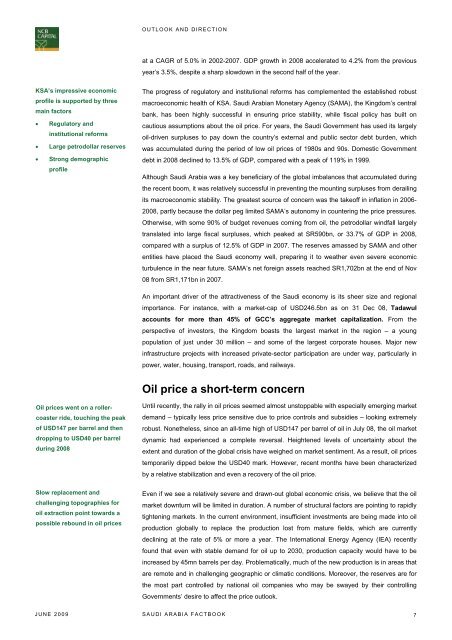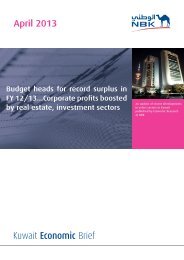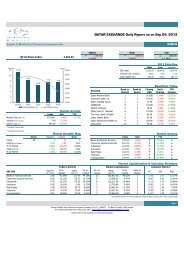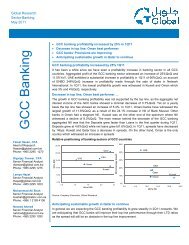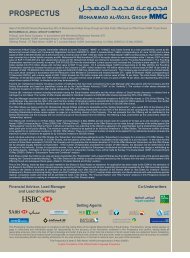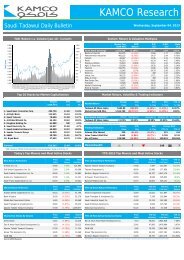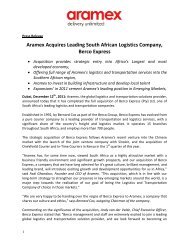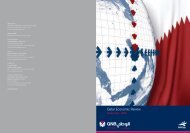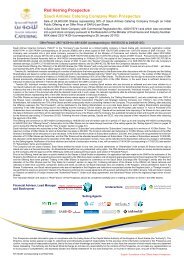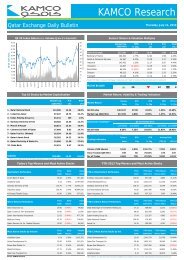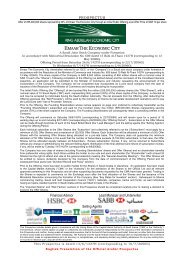to download the complete report - GulfBase.com
to download the complete report - GulfBase.com
to download the complete report - GulfBase.com
Create successful ePaper yourself
Turn your PDF publications into a flip-book with our unique Google optimized e-Paper software.
OUTLOOK AND DIRECTIONat a CAGR of 5.0% in 2002-2007. GDP growth in 2008 accelerated <strong>to</strong> 4.2% from <strong>the</strong> previousyear’s 3.5%, despite a sharp slowdown in <strong>the</strong> second half of <strong>the</strong> year.KSA’s impressive economicprofile is supported by threemain fac<strong>to</strong>rs• Regula<strong>to</strong>ry andinstitutional reforms• Large petrodollar reserves• Strong demographicprofileThe progress of regula<strong>to</strong>ry and institutional reforms has <strong>com</strong>plemented <strong>the</strong> established robustmacroeconomic health of KSA. Saudi Arabian Monetary Agency (SAMA), <strong>the</strong> Kingdom’s centralbank, has been highly successful in ensuring price stability, while fiscal policy has built oncautious assumptions about <strong>the</strong> oil price. For years, <strong>the</strong> Saudi Government has used its largelyoil-driven surpluses <strong>to</strong> pay down <strong>the</strong> country’s external and public sec<strong>to</strong>r debt burden, whichwas accumulated during <strong>the</strong> period of low oil prices of 1980s and 90s. Domestic Governmentdebt in 2008 declined <strong>to</strong> 13.5% of GDP, <strong>com</strong>pared with a peak of 119% in 1999.Although Saudi Arabia was a key beneficiary of <strong>the</strong> global imbalances that accumulated during<strong>the</strong> recent boom, it was relatively successful in preventing <strong>the</strong> mounting surpluses from derailingits macroeconomic stability. The greatest source of concern was <strong>the</strong> takeoff in inflation in 2006-2008, partly because <strong>the</strong> dollar peg limited SAMA’s au<strong>to</strong>nomy in countering <strong>the</strong> price pressures.O<strong>the</strong>rwise, with some 90% of budget revenues <strong>com</strong>ing from oil, <strong>the</strong> petrodollar windfall largelytranslated in<strong>to</strong> large fiscal surpluses, which peaked at SR590bn, or 33.7% of GDP in 2008,<strong>com</strong>pared with a surplus of 12.5% of GDP in 2007. The reserves amassed by SAMA and o<strong>the</strong>rentities have placed <strong>the</strong> Saudi economy well, preparing it <strong>to</strong> wea<strong>the</strong>r even severe economicturbulence in <strong>the</strong> near future. SAMA’s net foreign assets reached SR1,702bn at <strong>the</strong> end of Nov08 from SR1,171bn in 2007.An important driver of <strong>the</strong> attractiveness of <strong>the</strong> Saudi economy is its sheer size and regionalimportance. For instance, with a market-cap of USD246.5bn as on 31 Dec 08, Tadawulaccounts for more than 45% of GCC’s aggregate market capitalization. From <strong>the</strong>perspective of inves<strong>to</strong>rs, <strong>the</strong> Kingdom boasts <strong>the</strong> largest market in <strong>the</strong> region – a youngpopulation of just under 30 million – and some of <strong>the</strong> largest corporate houses. Major newinfrastructure projects with increased private-sec<strong>to</strong>r participation are under way, particularly inpower, water, housing, transport, roads, and railways.Oil price a short-term concernOil prices went on a rollercoasterride, <strong>to</strong>uching <strong>the</strong> peakof USD147 per barrel and <strong>the</strong>ndropping <strong>to</strong> USD40 per barrelduring 2008Until recently, <strong>the</strong> rally in oil prices seemed almost uns<strong>to</strong>ppable with especially emerging marketdemand – typically less price sensitive due <strong>to</strong> price controls and subsidies – looking extremelyrobust. None<strong>the</strong>less, since an all-time high of USD147 per barrel of oil in July 08, <strong>the</strong> oil marketdynamic had experienced a <strong><strong>com</strong>plete</strong> reversal. Heightened levels of uncertainty about <strong>the</strong>extent and duration of <strong>the</strong> global crisis have weighed on market sentiment. As a result, oil pricestemporarily dipped below <strong>the</strong> USD40 mark. However, recent months have been characterizedby a relative stabilization and even a recovery of <strong>the</strong> oil price.Slow replacement andchallenging <strong>to</strong>pographies foroil extraction point <strong>to</strong>wards apossible rebound in oil pricesEven if we see a relatively severe and drawn-out global economic crisis, we believe that <strong>the</strong> oilmarket downturn will be limited in duration. A number of structural fac<strong>to</strong>rs are pointing <strong>to</strong> rapidlytightening markets. In <strong>the</strong> current environment, insufficient investments are being made in<strong>to</strong> oilproduction globally <strong>to</strong> replace <strong>the</strong> production lost from mature fields, which are currentlydeclining at <strong>the</strong> rate of 5% or more a year. The International Energy Agency (IEA) recentlyfound that even with stable demand for oil up <strong>to</strong> 2030, production capacity would have <strong>to</strong> beincreased by 45mn barrels per day. Problematically, much of <strong>the</strong> new production is in areas thatare remote and in challenging geographic or climatic conditions. Moreover, <strong>the</strong> reserves are for<strong>the</strong> most part controlled by national oil <strong>com</strong>panies who may be swayed by <strong>the</strong>ir controllingGovernments’ desire <strong>to</strong> affect <strong>the</strong> price outlook.JUNE 2009SAUDI ARABIA FACTBOOK7


